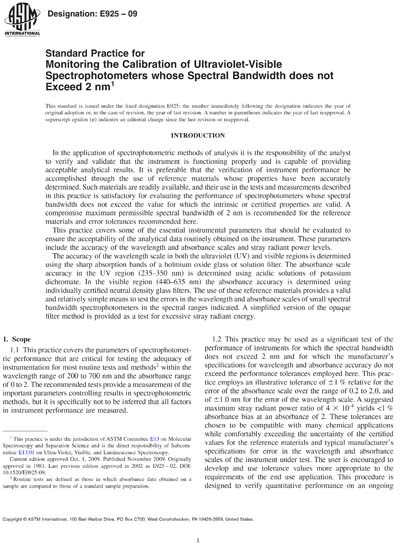Historical
ASTM E925-09
Standard Practice for Monitoring the Calibration of Ultraviolet-Visible Spectrophotometers whose Spectral Slit Width does not Exceed 2 nm
1.1 This practice covers the parameters of spectrophotometric performance that are critical for testing the adequacy of instrumentation for most routine tests and methods within the wavelength range of 200 to 700 nm and the absorbance range of 0 to 2. The recommended tests provide a measurement of the important parameters controlling results in spectrophotometric methods, but it is specifically not to be inferred that all factors in instrument performance are measured.
1.2 This practice may be used as a significant test of the performance of instruments for which the spectral bandwidth does not exceed 2 nm and for which the manufacturer's specifications for wavelength and absorbance accuracy do not exceed the performance tolerances employed here. This practice employs an illustrative tolerance of ±1 % relative for the error of the absorbance scale over the range of 0.2 to 2.0, and of ±1.0 nm for the error of the wavelength scale. A suggested maximum stray radiant power ratio of 4 × 10-4 yields <1 % absorbance bias at an absorbance of 2. These tolerances are chosen to be compatible with many chemical applications while comfortably exceeding the uncertainty of the certified values for the reference materials and typical manufacturer's specifications for error in the wavelength and absorbance scales of the instrument under test. The user is encouraged to develop and use tolerance values more appropriate to the requirements of the end use application. This procedure is designed to verify quantitative performance on an ongoing basis and to compare one instrument's performance with that of other similar units. Refer to Practice E275 to extensively evaluate the performance of an instrument.
1.3 This practice should be performed on a periodic basis, the frequency of which depends on the physical environment within which the instrumentation is used. Thus, units handled roughly or used under adverse conditions (exposed to dust, chemical vapors, vibrations, or combinations thereof) should be tested more frequently than those not exposed to such conditions. This practice should also be performed after any significant repairs are made on a unit, such as those involving the optics, detector, or radiant energy source.
1.4 The values stated in SI units are to be regarded as standard. No other units of measurement are included in this standard.
1.5 This standard does not purport to address all of the safety concerns, if any, associated with its use. It is the responsibility of the user of this standard to establish appropriate safety and health practices and determine the applicability of regulatory limitations prior to use.
Content Provider
ASTM International [astm]






